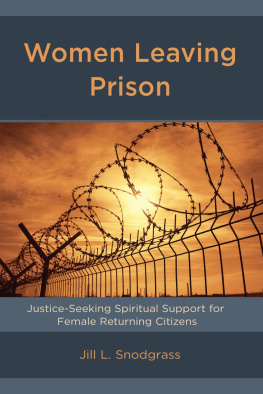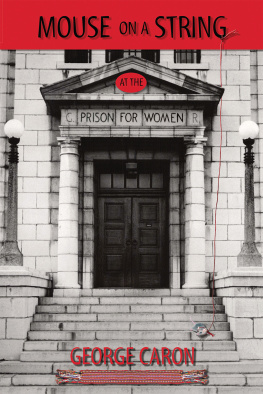First published 1965 by Transaction Publishers
Published 2017 by Routledge
2 Park Square, Milton Park, Abingdon, Oxon OX14 4RN
711 Third Avenue, New York, NY 10017, USA
Routledge is an imprint of the Taylor & Francis Group, an informa business
Copyright 1965 by David A. Ward and Gene G. Kassenbaum.
All rights reserved. No part of this book may be reprinted or reproduced or utilised in any form or by any electronic, mechanical, or other means, now known or hereafter invented, including photocopying and recording, or in any information storage or retrieval system, without permission in writing from the publishers.
Notice:
Product or corporate names may be trademarks or registered trademarks, and are used only for identification and explanation without intent to infringe.
Library of Congress Catalog Number: 2007012531
Library of Congress Cataloging-in-Publication Data
Ward, David A.
Womens prison : sex and social structure / by David A. Ward and Gene G.
Kassebaum.
p. cm.
Includes bibliographical references and index.
ISBN 978-0-202-30933-0 (alk. paper)
1. Womens prisonersCaliforniaSocial conditionsCase studies.
2. Women prisonersSexual behaviorCaliforniaCase studies.
3. LesbianismCaliforniaCase studies. 4. California Institution for Women (Frontera, Calif.) I. Kassebaum, Gene G. II. Title.
HV8738.W27 2007
365.430979495dc22
2007012531
ISBN 13: 978-0-202-30933-0 (pbk)
Preface
This study began with our interest in gathering data on women in prison to see whether there were female prisoner types consistent with the reported characteristics of male prisoners. Early in the course of this study it became apparent that the most salient distinction to be made among the female inmates was between those who were and those who were not engaged in homosexual behavior in prison, and further, of those who were so involved, between the incumbents of masculine and feminine roles.
Compared to the sociological literature on mens prisons, little is known about the social organization of the womens prison, and with the exception of the Gluecks Five Hundred Delinquent Women, (1934), virtually no systematically collected empirical data on female prisoners have been published.
Most of the descriptions of womens prisons are accounts by ex-superintendents and ex-inmates of which the best are Who Lie in Gaol, by Joan Henry, dealing with an English prisoners experiences, and Elizabeth Gurley Flynns commentary, The Alderson Story, written after her release from the Federal Reformatory for Women. There are no published monographs on the female prison community comparable to Donald Clemmers The Prison Community and Gresham Sykes The Society of Captives, and the most recent collections of articles and essays on the social organization of the prison contain no materials relating to female prisoners.
The numerous studies of male prisoners and the organization of the male prisoner community have laid the groundwork upon which the current experimental programs, large scale quantitative studies, and systematic evaluations of correctional effectiveness can be based. In the case of the womens prison, the first step of adequate description of the culture and social structure of the prison has not been taken. The present study is an effort to delineate these areas of sociological interest.
Few accounts have explicity treated the topic of prison homosexuality. Homosexuality is either not mentioned, disguised under terms such as relationships, or discussed only from a moralistic position. A half-dozen studies of homosexuality in training schools for young girls have been published by sociologists and psychologists, but we know of only one other on-going investigation of a prison for adult females, from which there have been no published reports to date.
The bulk of our knowledge of female homosexuality has been contributed by biologists, psychologists and psychoanalysts. Notable among these efforts are Sexual Behavior in the Human Female by Alfred C. Kinsey, War-dell B. Pomeroy, Clyde E. Martin, and Paul H. Gebhard; Sex Variants by George W. Henry; and Female Homosexuality by Frank S. Caprio. These reports, however, either do not discuss homosexuality which occurs in institutional settings, or mention this variety only briefly. The matter of homosexuality in prisons for men has received little sociological attention outside of the works of Clemmer and Sykes.
Most of the published studies of prisons for men have been conducted in about a half-dozen states and in the Federal Bureau of Prisons. Even in the most enlightened departments, there is still some reluctance to permit general descriptive studies which focus on aspects of imprisonment selected by the researcher, rather than on administrative ends suggested by the prison. This factor, combined with the sensitivity of prison superintendents to the political implications of studies of such problems, seldom encourages the kind of investigation we have conducted. A study of a boys training school reports that the superintendent of the institution was afraid to permit an inquiry into homosexuality because not that we should hide it, but people in other institutions never have any homosexuality, and our confessing it will make us the only one with it. What we have been able to do is unusual because we have been given the opportunity to do unrestricted research in an area of extreme sensitivity.
We were fortunate to find one of the few prisons in one of the few departments of corrections in the United States where an inquiry into prison homosexuality could be conducted. Such entry requires the approval and cooperation of the superintendent of the institution, permission of the department of corrections and the assistance of the prison staff. The key person in meeting these conditions was Iverne R. Carter, Superintendent of the California Institution for Women, Frontera, California. On our first visit to Frontera, Mrs. Carter pointed out that womens prisons had not been the subject of research and she challenged the assumption that female prisoners require the same kind of management as do males. She said that in her experience women acted differently in prison, had different problems and consquently, they needed different treatment. Our discussions in the pages to follow support these views.
We owe more to Mrs. Carter than gratitude for encouraging the study. She gave many hours of her time to discussions of the problems of the institution and the interests of the research. As the work proceeded she provided valuable insight and information about the operation of the institution, about the attitudes of the staff and about salient events in the past and the present of Frontera. She helped us make arrangements for the administration of questionnaires to the staff and to the inmates. We were provided private interviewing rooms, given access to prisoners records, and authorized to move freely throughout the institution and to sit in on meetings of the disciplinary court, group counseling sessions, and other activities. In addition, Mrs. Carter and Assistant Superintendent Mae Buwalda criticized drafts of articles and reports as they were readied for publication.
All of this impresses us as exceptional. Privately, homosexuality is admitted to be a feature of all large prisons for women but it is seldom that administrators are disposed to be receptive to, let alone promotive of, inquiry into this area. Mrs. Carter did just that and in a very real sense made this study possible.











